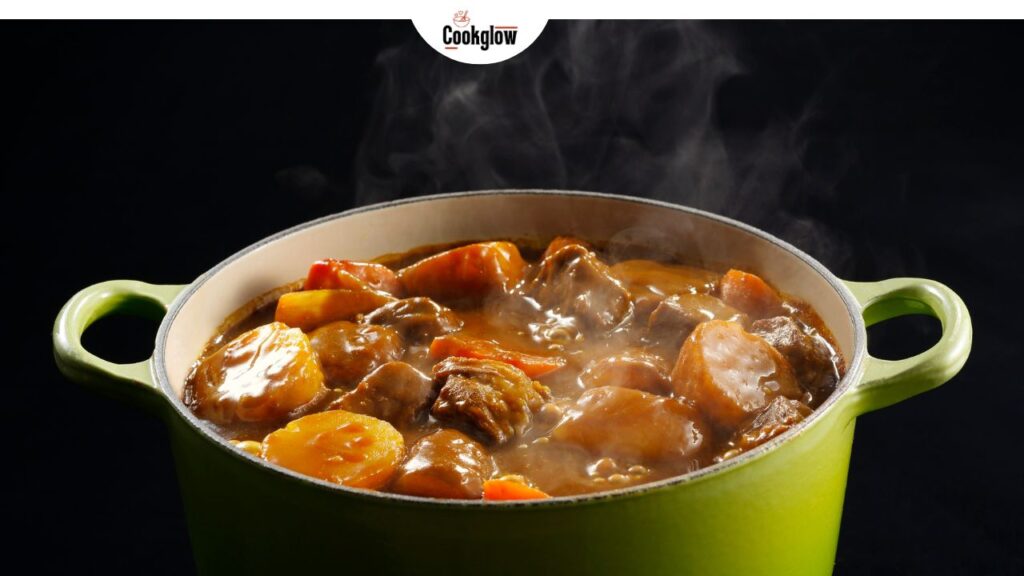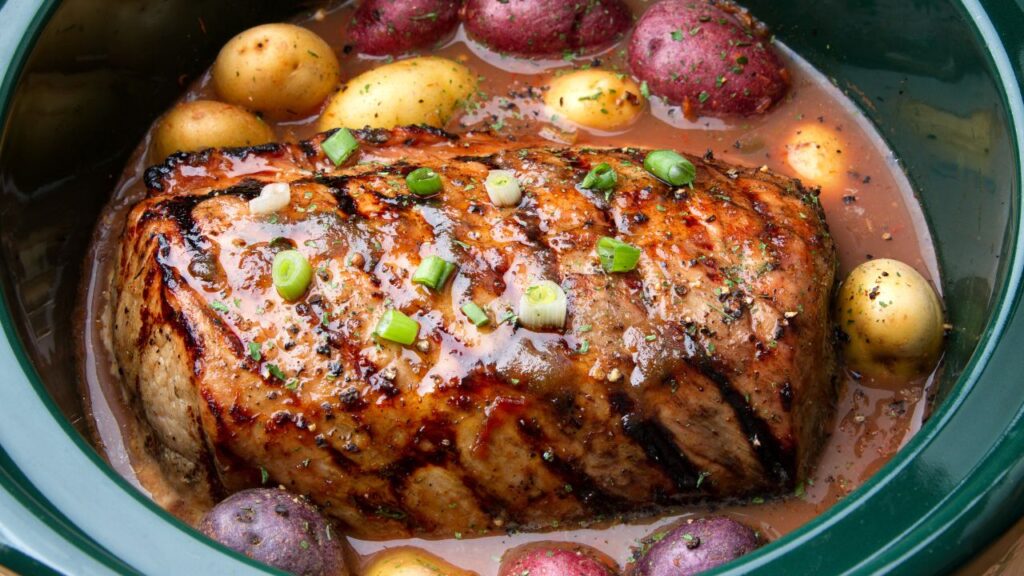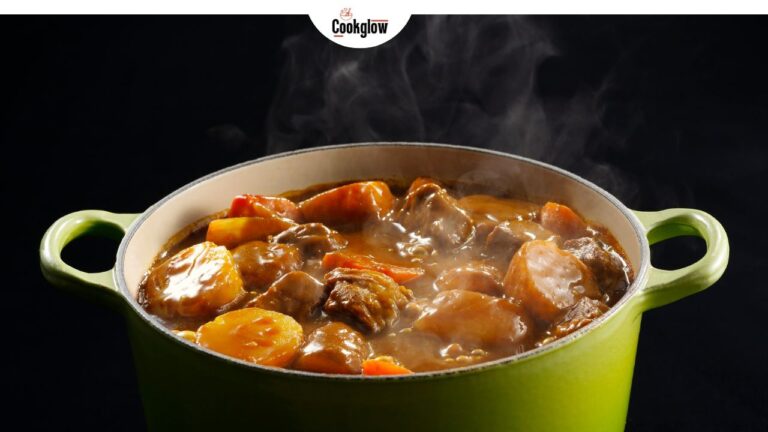
I still remember the first time I cooked an elk roast in a crock pot. I was excited but a little nervous—elk meat is lean, and I didn’t want to ruin it by overcooking or drying it out. But let me tell you, when I finally lifted the lid after hours of slow cooking, the aroma was incredible. The meat was tender, juicy, and packed with rich, deep flavors. Since then, I’ve perfected my method, and I’m here to share it with you.
Cooking elk roast in a slow cooker is one of the best ways to bring out its natural flavors while keeping it moist and tender. Because elk meat is much leaner than beef, it requires special care to prevent it from becoming tough. That’s where the crock pot shines—it cooks low and slow, allowing the meat to soak up all the flavors from your seasonings and broth.
In this guide, I’ll walk you through everything you need to know about how to cook elk roast in a crock pot for a tender, flavorful, and juicy meal with simple ingredients and tips. You’ll learn:
✔️ The best cuts of elk roast for slow cooking
✔️ How to season and prep your roast for maximum flavor
✔️ Step-by-step cooking instructions with time and temperature guides
✔️ Pro tips to keep your elk roast juicy and tender
✔️ Delicious side dishes and serving ideas
Whether you’re cooking elk for the first time or looking for a foolproof recipe to perfect your skills, this guide has you covered. Let’s get started!
Contents
- 1 Nutritional Profile of Elk Roast
- 2 Why Elk Roast is a Healthy Choice
- 3 Choosing the Right Elk Roast Cut
- 4 Best Cuts for Slow Cooking
- 5 Where to Buy Elk Meat
- 6 How to Prepare Your Elk Roast Before Cooking
- 7 Prepping Elk Roast for Slow Cooking
- 8 Should You Sear the Roast Before Slow Cooking?
- 9 How to Sear Elk Roast for Maximum Flavor
- 10 Best Seasonings and Ingredients
- 11 Cooking Instructions: Slow Cooker Method
- 12 Tips for Extra Tender Elk Roast
- 13 Common Mistakes to Avoid
- 14 Serving Suggestions & Side Dishes
- 15 Conclusion
- 16 FAQs About Cooking Elk Roast in a Crock Pot
Nutritional Profile of Elk Roast
Elk meat is a powerhouse of nutrition, making it a fantastic alternative to beef. It’s naturally lean, high in protein, and packed with essential vitamins and minerals. If you’re looking for a healthy yet flavorful meal, elk roast is an excellent choice.
To help you understand how elk compares to other meats, here’s a quick breakdown:
| Nutrient (per 3.5 oz serving) | Elk Roast | Beef Roast (Lean) | Venison Roast |
| Calories | 137 | 250 | 158 |
| Protein (g) | 26 | 22 | 30 |
| Fat (g) | 2.7 | 15 | 3.2 |
| Saturated Fat (g) | 0.9 | 5.8 | 1.4 |
| Iron (mg) | 3.3 | 2.1 | 4.5 |
| Cholesterol (mg) | 65 | 72 | 66 |
Why Elk Roast is a Healthy Choice
✔️ Low in Fat – With only about 2.7g of fat per serving, elk is one of the leanest red meats available.
✔️ High in Protein – Provides 26g of protein per serving, making it great for muscle recovery and overall health.
✔️ Rich in Iron – Helps boost energy and supports healthy red blood cells.
✔️ Lower in Calories – Compared to beef, elk has fewer calories while still being flavorful and filling.
Elk roast is a perfect option if you want a high-protein, nutrient-dense meal without the extra fat and calories of traditional beef. Now that we know why elk is such a great choice, let’s move on to selecting the right cut for slow cooking!
Choosing the Right Elk Roast Cut
Not all cuts of elk roast are created equal—some work better in a crock pot than others. Since elk is leaner than beef, picking the right cut is key to ensuring a tender, flavorful result.

Best Cuts for Slow Cooking
For the crock pot, you’ll want to choose cuts with a bit more connective tissue. These cuts break down over time, making the meat fall-apart tender. Here are the best options:
- Chuck Roast – This cut comes from the shoulder and has just enough connective tissue to turn buttery soft when slow-cooked.
- Rump Roast – A great option from the back leg that benefits from low and slow cooking.
- Shank (Osso Buco Style) – Contains lots of collagen, which melts into the broth, adding incredible richness.
- Neck Roast – A flavorful cut that becomes tender with long cooking times.
Where to Buy Elk Meat
If you don’t hunt your own elk, don’t worry—you can still find high-quality elk meat:
- Local Butchers & Wild Game Processors – Some specialty butchers carry elk meat, especially in regions where hunting is common.
- Online Wild Game Suppliers – Websites like The Honest Bison, Broken Arrow Ranch, and Northstar Bison offer high-quality, farm-raised elk meat.
- Farmers’ Markets & Specialty Stores – Some vendors sell elk meat at farmers’ markets or gourmet grocery stores.
How to Prepare Your Elk Roast Before Cooking
- Trim Excess Silver Skin – This thin, silvery membrane doesn’t break down during cooking, so it’s best to remove it with a sharp knife.
- Leave a Little Fat – While elk is lean, if your roast has a bit of fat, leave it on for extra moisture and flavor.
- Thaw Properly – If using frozen elk roast, let it thaw slowly in the fridge for 24–48 hours for the best texture.
Choosing the right cut is the first step in cooking a tender and delicious elk roast. Now, let’s move on to the next important step—prepping the roast for slow cooking!
Prepping Elk Roast for Slow Cooking
Before tossing your elk roast into the crock pot, a little prep work goes a long way in making it flavorful and tender. This step is where you build layers of taste and ensure the meat stays juicy during the long cooking process.
Should You Marinate Elk Roast?
Elk is naturally lean, which means it can sometimes turn out a bit dry if not handled properly. Marinating helps tenderize the meat and adds extra depth of flavor.
Best Marinade Options for Elk Roast
If you have time, marinate your elk roast for 4–12 hours before cooking. Here are a few options based on different flavor profiles:
- Classic Herb Marinade: Olive oil, garlic, rosemary, thyme, salt, and black pepper.
- Bold & Smoky Marinade: Worcestershire sauce, soy sauce, smoked paprika, and a splash of liquid smoke.
- Tangy & Tenderizing Marinade: Red wine, balsamic vinegar, Dijon mustard, and a touch of honey.
If you’re short on time, don’t worry! A dry rub can work just as well.
Dry Rub vs. Wet Marinade – Which One to Choose?
| Method | Pros | Best For |
| Wet Marinade | Adds moisture, tenderizes, and enhances flavor | Leaner or tougher cuts like rump and shank |
| Dry Rub | Creates a flavorful crust and is quicker | Well-marbled cuts like chuck roast |
Should You Sear the Roast Before Slow Cooking?
The short answer? Yes, if you want the best flavor.
Searing the roast before slow cooking caramelizes the surface, locking in juices and creating a rich, savory taste. Here’s how to do it:
How to Sear Elk Roast for Maximum Flavor
- Pat Dry – Remove excess moisture with a paper towel to help the roast brown properly.
- Heat a Cast-Iron Skillet – Add a bit of oil (I like avocado or butter) over medium-high heat.
- Sear for 2-3 Minutes Per Side – Brown all sides for a deep, flavorful crust.
- Deglaze the Pan – Pour in a splash of broth or wine to scrape up the browned bits—this adds amazing flavor to your slow cooker sauce!
Now that your elk roast is prepped and ready, it’s time for the main event—cooking it to perfection in the crock pot!

Best Seasonings and Ingredients
Seasoning an elk roast properly is the secret to making it taste amazing. Since elk has a rich, slightly sweet, and earthy flavor, you want seasonings that enhance its natural taste without overpowering it.
Essential Spices & Herbs for Elk Roast
Here are my go-to seasonings that work beautifully with elk:
✔️ Garlic & Onion Powder – Adds depth and enhances the meat’s savory notes.
✔️ Black Pepper & Sea Salt – Simple but essential for bringing out elk’s natural flavors.
✔️ Rosemary & Thyme – Classic herbs that pair well with wild game.
✔️ Smoked Paprika – Adds a hint of smokiness, perfect for slow cooking.
✔️ Cumin & Coriander – Give a warm, slightly nutty flavor.
✔️ Bay Leaves – A must for slow cooking to infuse the broth with aroma.
Best Liquids for Slow Cooking Elk Roast
Elk needs moisture to stay juicy, and the right liquid base makes a big difference:
- Beef or Bone Broth – Adds richness and depth to the roast.
- Red Wine – A great option for an elegant, restaurant-quality taste.
- Worcestershire Sauce or Soy Sauce – Boosts umami and enhances flavor.
- Balsamic Vinegar – Adds a touch of acidity to balance the richness.
Vegetables to Cook Alongside Elk Roast
A slow-cooked elk roast isn’t complete without hearty veggies. These absorb the juices and make for a well-rounded meal:
🥕 Carrots – Naturally sweet and balance out the meat’s richness.
🥔 Potatoes – Soak up the flavorful broth, making them extra delicious.
🧅 Onions – Add depth and a bit of natural sweetness.
🌿 Celery – Provides a subtle, aromatic flavor.
Cooking Instructions: Slow Cooker Method
Now that your elk roast is prepped and seasoned, it’s time to get cooking!
Step-by-Step Instructions
Prepare the Crock Pot
- Add a layer of sliced onions, garlic, and celery to the bottom—this creates a natural rack for the roast to sit on.
- Pour in 1–2 cups of broth or liquid of choice.
Place the Roast in the Slow Cooker
- If marinated, pat it dry slightly before placing it in the crock pot.
- Add carrots and potatoes around the roast.
- Sprinkle in additional seasonings if desired.
Set the Cooking Time & Temperature
- Low Setting (Best Option): 6–8 hours for fall-apart tenderness.
- High Setting: 4–5 hours, but the meat may be slightly less tender.
Check for Doneness
Elk is lean, so use a meat thermometer to ensure it’s cooked perfectly:
| Doneness Level | Internal Temperature |
| Medium-Rare | 130°F |
| Medium | 140°F |
| Well Done (Not Recommended) | 150°F+ |
Tip: For the juiciest meat, I recommend 130–140°F, then letting it rest before slicing.
Let It Rest & Slice Properly
- Remove the roast from the crock pot and let it rest for 10–15 minutes—this allows the juices to redistribute.
- Slice against the grain for the most tender bites.
Tips for Extra Tender Elk Roast
✔️ Cook Low and Slow – Elk’s lean meat benefits from longer, lower temperatures.
✔️ Use Enough Liquid – Prevents drying out and keeps the roast juicy.
✔️ Add a Bit of Fat – A pat of butter or drizzle of olive oil helps add moisture.
✔️ Don’t Overcook! – Going past 140°F will make it tougher.
Common Mistakes to Avoid
❌ Skipping the Sear – You’ll lose out on that deep, caramelized flavor.
❌ Using Too Little Liquid – Can result in a dry, tough roast.
❌ Overcooking It – Elk is lean, so keeping an eye on temperature is crucial.
❌ Not Letting It Rest – Cutting too soon lets all the juices escape.
Serving Suggestions & Side Dishes
A beautifully cooked elk roast deserves the perfect sides. Here are some great pairings:
🍷 Wine Pairing: A bold red like Cabernet Sauvignon or Malbec.
🥔 Mashed Potatoes: Creamy and buttery to complement the rich meat.
🍞 Rustic Bread: Perfect for soaking up those slow-cooked juices.
🥦 Roasted Brussels Sprouts: A slightly bitter contrast to balance flavors.
| Type of Beverage | Recommended Options |
| Red Wine | Cabernet Sauvignon, Syrah, Malbec |
| Beer | Dark Ale, Stout |
| Non-Alcoholic | Cranberry Juice, Black Tea |
Conclusion
There you have it—everything you need to make a perfect elk roast in a crock pot! From choosing the right cut to seasoning, slow cooking, and serving, this guide covers it all.
Elk roast is a fantastic way to enjoy wild game—it’s lean, nutritious, and full of rich, natural flavors. With the right technique, you can create a tender, mouthwatering dish that will impress your family and guests.
So go ahead, grab your slow cooker, season that elk roast, and get ready for a delicious, fall-apart meal! And if you try this recipe, let me know how it turned out—I’d love to hear your experience!
FAQs About Cooking Elk Roast in a Crock Pot
1. Does elk roast taste gamey?
Not really! Elk has a mild, slightly sweet, and earthy flavor. If cooked properly and seasoned well, it tastes similar to a lean beef roast but with a richer depth.
2. How do I make elk roast more tender?
✔️ Cook it low and slow in the crock pot for the best texture.
✔️ Use enough liquid (broth, wine, or a marinade) to keep it moist.
✔️ Let it rest before slicing to retain juices.
✔️ Slice against the grain for the most tender bites.
3. Can I cook elk roast from frozen?
It’s best to thaw elk roast in the fridge for 24–48 hours before cooking. However, if you’re in a rush, you can cook it from frozen—just increase the cooking time by 2–3 hours on low and make sure to use a thermometer to check doneness.
4. What’s the best internal temperature for elk roast?
For the juiciest meat, aim for:
| Doneness | Temperature |
| Medium-Rare | 130°F |
| Medium | 140°F |
Going past 140°F may result in a tougher texture since elk is very lean.
5. Can I add other vegetables or seasonings?
Absolutely! Feel free to experiment with flavors. Some great additions include:
- Parsnips or Sweet Potatoes – For a slightly sweeter contrast.
- Mushrooms – Adds an earthy umami flavor.
- Crushed Tomatoes – Enhances the richness of the broth.
6. What can I do with leftover elk roast?
Leftover elk roast is super versatile! Try these ideas:
- Shred it for tacos with a smoky chipotle sauce.
- Make elk sandwiches with horseradish mayo.
- Use it in a stew by simmering it with extra broth and veggies.
- Turn it into breakfast hash with crispy potatoes and eggs.
7. How long do elk roast leftovers last?
Store leftovers in an airtight container in the fridge for 3–4 days. You can also freeze them for up to 3 months. To reheat, warm gently in a skillet or the oven to avoid drying out.

